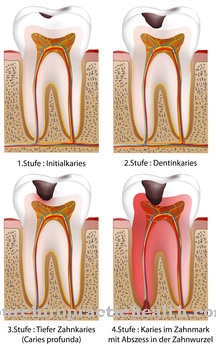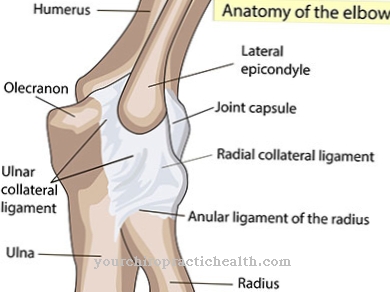This is one of the many skin diseases seborrheic eczema or the seborrheic dermatitis relatively often. Around 3 percent of the total population suffers from this skin inflammation. In babies and young children this condition is also called Head gneiss designated.
What is seborrheic eczema?

© blueringmedia - stock.adobe.com
A seborrheic eczema is a rash. It mainly affects the face and scalp. This usually results in yellowish and greasy flakes. The skin under the scales is reddened.
Seborrheic eczema is commonly seen in newborns. After that, seborrheic eczema usually occurs between the ages of 20 and 40. Men are affected more frequently than women. These often develop seborrheic eczema after the menopause.
Other areas of the skin on the chin, eyebrows and nose can also be affected. In particularly severe cases, seborrheic dermatitis was diagnosed on the back, along the spine. Seborrheic eczema also spreads to the breastbone or ears.
causes
The creation of the seborrheic eczema has not yet been fully explored. It is estimated that over 50 percent of the world's population has a genetic predisposition to seborrheic eczema.
So it doesn't have to break out automatically. The immune or nervous system often plays an important role. The high number of Parkinson's disease or AIDS patients suffering from seborrheic eczema is striking. Almost 80 percent of AIDS patients are affected by this disease. Further causes for the onset of seborrheic eczema can be psychological stress and profuse sweating.
The use of high-fat skin care products also promote the occurrence of seborrheic eczema. Metabolic disorders can also play a role. The yeast "Malassezia furfur" should be mentioned in particular. It belongs to the human skin flora. However, if its cells divide excessively, the development of seborrheic eczema can be favored.
Symptoms, ailments & signs
Seborrheic eczema is a scaly skin rash. This chronic inflammatory skin disease occurs primarily on the scalp. The disease is not to be confused with conventional dandruff. These are dry, rather small and white. The scales typical of seborrheic dermatitis are larger, yellowish and usually sticky.
Seborrheic eczema can already affect babies. Hence the name "head gneiss" comes from. The most common complaint about the disease is men between the ages of 30 and 40. The skin disorder is also known to accompany Parkinson's disease and AIDS. Clear symptoms are reddened areas of the skin and yellowish scales on them.
There are sometimes massive foci of inflammation, which are aggravated by frequent scratching. Many patients have increased dandruff. Seborrheic eczema can spread to several areas of the skin. Itching is rare. Those affected do not feel any pain in the affected areas.
In addition to the scalp, the face can also be affected. There is also inflammation of the eyelids. The damaged skin areas are a gateway for fungi and bacteria. In some cases, those affected also complain of hair loss. However, there is no direct connection to seborrheic dermatitis.
Diagnosis & course
The seborrheic eczema is relatively easy to diagnose. The dermatologist (dermatologist) often recognizes this disease at first glance. The characteristic, yellowish flakes of skin and the affected areas allow a quick diagnosis in most cases.
However, skin reddening is often caused by allergies. For this purpose, the patient is subjected to an allergy test. It becomes clear relatively quickly whether an allergy or seborrheic eczema is the cause of the reddening of the skin. To rule out another skin disease, the dermatologist takes a skin sample from the patient under local anesthesia. The flakes of skin are examined microscopically. Because seborrheic eczema is a chronic skin condition, it cannot be completely cured.
The course of seborrhiosic eczema mostly depends on the seasons. Patients get sick more often in winter than in the summer months. The increased UV radiation in summer inhibits the cell division of the yeast "Malassezia furfur". This means that seborrheic dermatitis occurs less frequently in summer.
Complications
When infested in infancy, seborrheic eczema often causes further fungal or bacterial infections in the affected skin areas. Such a superinfection can also occur in adults. In addition, the skin disease in babies can lead to severe fever with vomiting and diarrhea, often accompanied by dehydration, deficiency symptoms and severe circulatory problems.
In adults, sebboriheic eczema can quickly develop into a chronic condition. This takes place in spurts and often causes complaints for a lifetime - always in spurts and therefore often psychologically very stressful for those affected. If the weakened skin is injured, inflammation and bleeding occur. The aforementioned superinfections are among the most serious complications of the skin disease.
Adverse events can also occur during treatment. The ointments, lotions or shampoos used can, for example, trigger allergic reactions or cause side effects and interactions. Typically used active ingredients such as itraconazole and terbinafine often cause gastrointestinal complaints, skin rashes and infections of the upper respiratory tract.
Visual disturbances, ringing in the ears or hair loss can occur very rarely. Secondary diseases such as serum sickness or cardiac insufficiency are also conceivable after taking the appropriate preparations.
When should you go to the doctor?
This disease should always be treated by a doctor. It cannot heal on its own, so that the person concerned is dependent on treatment by a doctor. Only with early and correct treatment of this disease can further complications and complaints be prevented. A doctor should therefore be consulted at the first signs of this disease. A doctor should be consulted if the person concerned suffers from a severe rash. This spreads all over the body and significantly reduces the feeling of well-being of the person concerned.
Dandruff can also develop, which can also cover the entire skin, whereby itching can also indicate the disease. In some cases, hair loss also indicated this disease and should be examined by a doctor. First and foremost, a general practitioner or a dermatologist can be seen in this disease. This then usually also carries out the treatment. Since the illness can also lead to mental moods or depression, a psychologist should be consulted in these cases to treat them.
Treatment & Therapy
Treating a seborrheic eczema occurs during an acute attack and the period between two illnesses. During an acute episode, the patient receives an antimyotic from the doctor. It can be found in creams or shampoos. Here hair shampoos with the active ingredients salicylic acid and selenium disulfide have proven themselves.
Urea creams are also an option. In the case of severe symptoms, the patient is given antimyotics in tablet form. So-called phototherapy is also used for acute complaints. The patient is injected with a drug. The light treatment takes place after a few hours. The cells of the seborrheic eczema are irradiated for a few minutes. Together with the previously injected drug, the cells are then destroyed. Treatment between illnesses should be applied constantly.
The care products already described should be used regularly. Since psychological factors also favor the occurrence of seborrheic eczema, relaxation exercises or autogenic training help. In the case of seborrheic dermatitis, washing the affected areas of the skin with a saline solution has also proven its worth. A gentle peeling of the skin flakes with a washcloth can also help with seborrheic eczema.
prevention
Regular care and sufficient UV radiation are preventive measures. Rest and stress relief also inhibit the onset of seborrheic eczema. Thus, the disease can be effectively prevented.
Medical follow-up care is rarely necessary for seborrheic dermatitis. Infants and toddlers, for example, can be expected to heal without consequences, so that further measures are not necessary.
Aftercare
For all other sufferers, follow-up care is geared towards possible consequential damage and the level of suffering caused by seborrheic eczema. In excessive cases, for example, severe scratching, associated wounds and ultimately infections may have occurred. Individual skin areas that are heavily infected with bacteria are possible and require intensive wound care even after the treatment of seborrheic eczema.
A distinction must be made here as to whether or not antibiotics are necessary. In this context, aftercare also includes preventing scratching. The itching caused by oozing wounds that sufferers have inflicted on themselves as a result of scratching is sometimes indistinguishable from that of eczema.
Otherwise, correct skin treatment is considered the best aftercare. Factors that could cause the seborrheic eczema to flare up should be minimized. It is primarily a question of certain skin fungi, the growth of which is hindered by UV radiation and dryness. Avoiding greasy creams and soaps on the skin can better maintain the protective acid mantle and promote healing.
You can do that yourself
In addition to the itching, seborrheic dermatitis also causes inconvenience in everyday life due to the visual anomalies. However, patients should absolutely resist the sometimes severe itching, as touching the diseased skin areas or even scratching the healing process is by no means beneficial. The medically prescribed shampoos or ointments must be used. Without such medicinal agents, seborrheic eczema is difficult to heal in adults.
If the diseased areas on the scalp are noticeable as cosmetic blemishes, a change in the hairstyle may partially or completely hide the seborrheic eczema. The majority of those affected not only suffer from physical complaints, but also from shame in the face of eczema. If seborrheic eczema affects the skin beyond the head, long clothing can cover up the condition and thereby reduce the feeling of shame. At best, patients choose loose clothing that does not irritate the skin. The clothes should be made of natural materials or other skin-friendly fibers and should not give off any irritating dyes.
Extreme caution is also required when shaving diseased skin areas in order not to injure the seborrheic dermatitis and not to infect other parts of the body. Finally, seborrheic eczema requires patience and long-term use of the medicinal ointments.




.jpg)

.jpg)






.jpg)

.jpg)
.jpg)











.jpg)